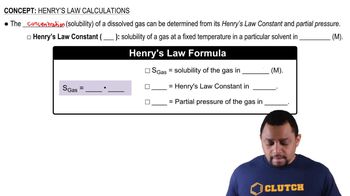Here are the essential concepts you must grasp in order to answer the question correctly.
Henry's Law
Henry's Law states that the amount of gas that dissolves in a liquid at a given temperature is directly proportional to the partial pressure of that gas above the liquid. This relationship can be expressed mathematically as C = kH * P, where C is the concentration of the gas in the liquid, kH is the Henry's law constant, and P is the partial pressure of the gas.
Recommended video:
Solubility
Solubility refers to the maximum amount of a substance that can dissolve in a given volume of solvent at a specific temperature and pressure. In the context of gases, solubility is often expressed in mol/L and is influenced by factors such as temperature, pressure, and the nature of the gas and solvent.
Recommended video:
Partial Pressure
Partial pressure is the pressure exerted by a single component of a mixture of gases. In the context of solubility, it is the pressure of the gas above the liquid that affects how much of that gas can dissolve in the liquid. Understanding partial pressure is crucial for applying Henry's Law to calculate solubility.
Recommended video:
Partial Pressure Calculation
 Verified step by step guidance
Verified step by step guidance

